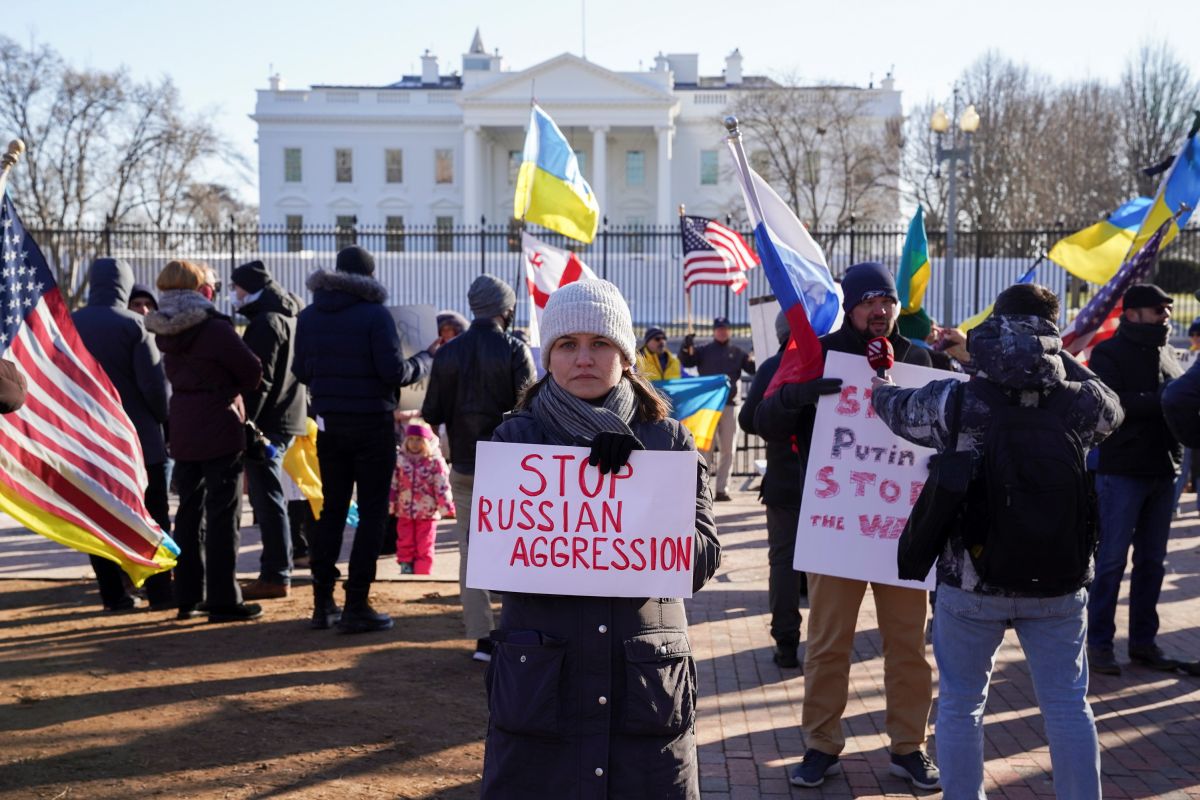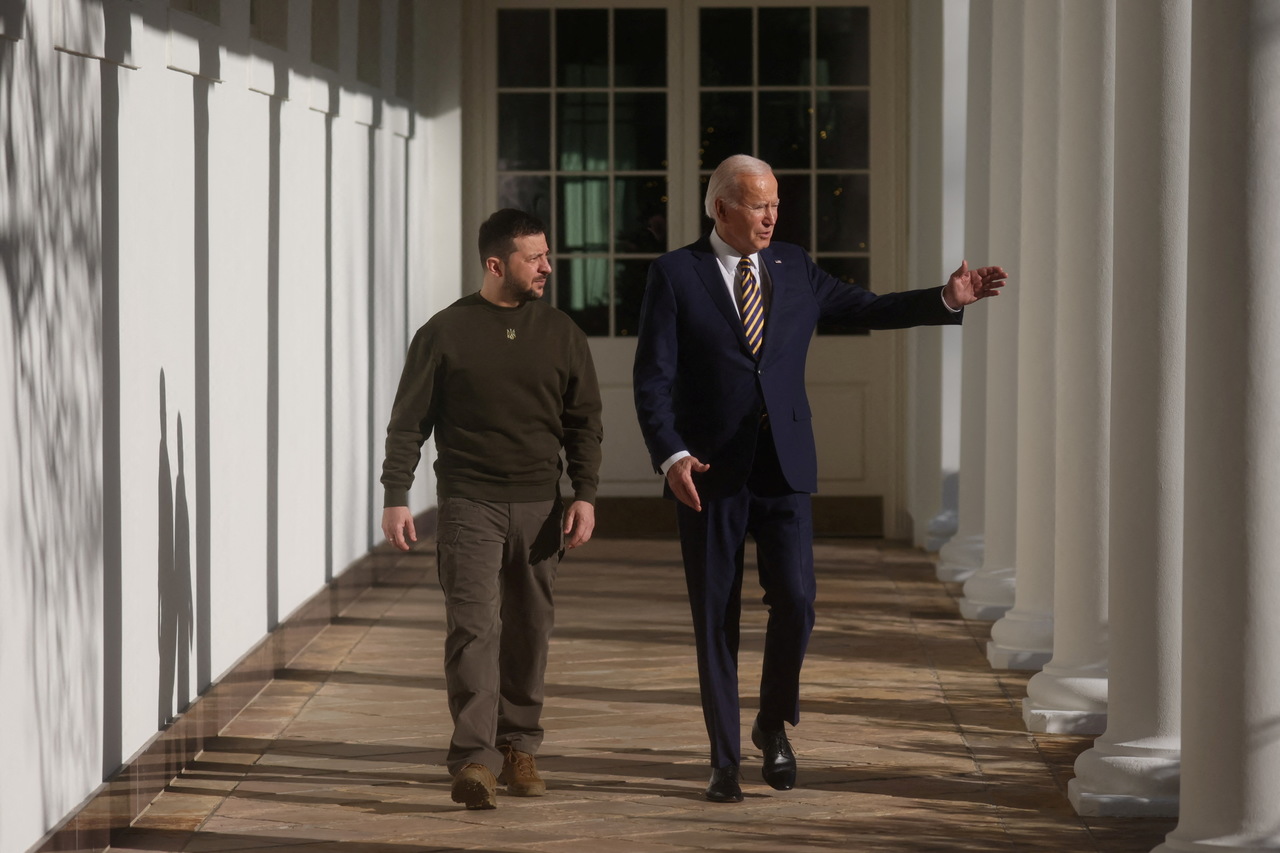Congress Key to U.S. Support for Ukraine One Year After the Russian Invasion
The Republicans’ majority in the House of Representatives may slow down or reduce American support for Ukraine. The problem is not only the opposition of some Republicans to the assistance itself but above all, the attempts to reduce budget expenditures and reduce the deficit. This may prompt the Biden administration to use the approved funds sparingly and provide only the most necessary elements of support for fear that Congress will not allocate additional funds before the next fiscal year.
 Prezydencja na Ukrainie/Pre ukraińskie/Prasa Zuma/Forum
Prezydencja na Ukrainie/Pre ukraińskie/Prasa Zuma/Forum
U.S. support is crucial to Ukraine’s ability to defend itself and recapture Russian-occupied territories, including Crimea, and to maintaining the state and providing assistance to those affected. The main component of U.S. aid is military support, which accounts for $29.3 billion of the total $44.2 billion in assistance for Ukraine since the beginning of the full-scale Russian invasion in February 2022. The U.S. has so far provided, among others, Javelin anti-tank systems (8,000), Stinger anti-aircraft systems (1,600), Phoenix Ghost loitering munition (1,800) and Switchblades (700), MRAP armoured vehicles (more than 500), M113s (300), M1117s (250) and M109, M198, and M777 howitzers (160 in total). In the coming weeks, modern Bradley (109) and Stryker (90) combat vehicles will be delivered, while Patriot systems (one battery, eight launchers) and Abrams tanks (31) will arrive in at least a few months.
Military Support Mechanisms
The U.S. provides military assistance to Ukraine using three political and administrative mechanisms. The main one is the Presidential Drawdown Authority (PDA), which allows the transfer of equipment from the warehouses of the Department of Defense. The Biden administration has so far authorised 31 drawdowns, including 29 after the invasion, worth a total of $18.5 billion.
The second instrument is the Ukraine Security Assistance Initiative (USAI), treated as an element of long-term support for Ukraine. However, this process is more time-consuming than the PDA because the equipment and armaments are ordered by the administration from the manufacturer. The USAI is also used to provide logistical support, soldiers’ training, military advice, and intelligence sharing. Since the beginning of the invasion, the USAI has been used 10 times ($9.35 billion in total), including to provide Ukraine with ammunition and missiles, NASAMS systems (two out of the eight ordered systems have already been delivered) and Abrams tanks (not yet ordered).
The third form is Foreign Military Financing (FMF), a programme of non-repayable grants by the State Department for the purchase of American arms (through the Foreign Military Sales procedure), services, and training. Since the beginning of the invasion, the U.S. has transferred about $1.5 billion to Ukraine via the FMF. At the same time, the U.S. also provided grants from this programme to other allies involved in arming Ukraine (a total of $3.3 billion, including $289 million for Poland). The USAI and FMF have been regularly used in support of Ukraine since 2016.
The Excess Defense Articles (EDA) programme (used to transfer at reduced cost or free of charge equipment that the Department of Defense considers redundant) and the Lend-Lease mechanism have not been used since the beginning of the invasion. The EDA has been used in the past to supply Ukraine with U.S.-owned Mi-17 helicopters, among other things. In May, Congress passed the Ukraine Democracy Defense Lend-Lease Act, which relaxes the rules of equipment leases to Ukraine. However, it does not introduce new transfer mechanisms and does not allocate additional funds, which makes it different from the Lend-Lease provisions of World War II and reduces its importance. The use of Lend-Lease would also entail Ukraine incurring part of the costs.
Economic and Humanitarian Aid
Non-military aid is distributed by the Agency for International Development (USAID), in cooperation with the State and Treasury departments. Since the beginning of the invasion, the U.S. has provided $13 billion in economic and more than $1.9 billion in humanitarian aid. Direct financial support enabling the functioning of schools and hospitals and the payment of salaries to administration and services is transferred to Ukraine through the World Bank. It is no less important than military support because of the punctuality of American payments, which is not the case for funds from the European Union. In turn, humanitarian aid is delivered in cooperation with 20 international partners, including the IOM, UNHCR, UNICEF, and WHO. Although the aid is provided in response to the Russian invasion, the recipients include not only Ukraine but also eight other European countries (Moldova, Poland, and Romania among them). These countries altogether have received about $344 million s far to support refugees. Ukraine has received sanitation and hygiene products worth $79 million, $372 million in direct financial support, food aid worth $273 million, and $271 million for energy support and preparation for winter. Humanitarian aid is also used to provide health and psychological care as well as shelter.
The Role of Congress
U.S. aid is funded from the federal budget, approved by Congress for the fiscal year, or from special appropriations requested by the president. Biden has requested aid funding four times since the invasion began, totalling $113 billion. Congress raised the quotas three times beyond the president’s request and met it once. These measures, however, serve not only as direct assistance but also to replenish DoD stocks of equipment and ammunition arising from the transfers to Ukraine, as well as financing the activities of the U.S. troops (including logistics) and helping refugees. In addition, Congress also manages the PDA financial limit.
Of the funds allocated so far to Ukraine, there remains about $5 billion in the PDA, $8.65 billion in the USAI, $1.6 billion in the FMF, $8.9 billion in economic aid, and about $2 billion in humanitarian aid (funds from the FMF and humanitarian aid may also cover other countries). At least a few of them will be depleted in the coming months, so before the end of the current fiscal year (end of September). Biden is expected to ask Congress for another pool of funding.
Possible Political Restrictions
Some Republicans, who took control the House of Representatives in January, oppose further support for Ukraine. For some, it reflects a pro-Russia attitude and dislike of Ukraine among some in Congress who are supporters of Donald Trump, as well as isolationists from the libertarian faction. The opposition to more aid also stems from conservative voter pressure. Currently, only 48% of these voters support further support for Ukraine, compared to 75% in March. The reluctance of other Republicans stems from the demand to cut budget spending and reduce the deficit. However, there are internal discrepancies within the party as to whether the cuts should cover the entire federal budget or only non-military expenditures. The pro-Russian, anti-Ukrainian, and spending-reduction sentiments are stronger among Republicans in the House than in the Senate, which remains under Democratic control. In May, when Congress voted on the second aid package for Ukraine ($40 billion), 57 Republicans in the House and 11 in the Senate opposed it.
The adoption in December of the fourth package of funding ($47.3 billion, the highest so far) before the swearing-in of the new Congress gave the Biden administration several months of breathing room in providing assistance for Ukraine. Congress should adopt a budget for fiscal year 2024 by October, although this is highly unlikely given the need to agree it between the two chambers of Congress, now controlled by rival parties (the last time all 12 of the required budget bills were adopted on time was in 1997). The discussion around the budget, as well as any extra-budget expenses, including aid to Ukraine, will also be hindered by a statutory debt spending limit (“debt ceiling”), which now is forcing the administration to implement special austerity measures until the limit is raised.
Conclusions and Perspectives
With the adoption of the fourth funding package by Congress at the end of 2022, support for Ukraine will continue in the coming months. Problems may arise later, though with the need for Congress to approve further funds for this purpose. Linking aid to Ukraine with broader budget problems will make it more difficult to adopt them. Some Republicans are expected to press for spending cuts, mainly in the area of economic and humanitarian aid, but it cannot be ruled out that there will be attempts to reduce spending on military support. At the same time, the Republicans will demand greater supervision and auditing of assistance already provided, including military aid. This may cause the Biden administration to be reluctant to transfer new, expensive types of weapons, including aircraft (F-16) or long-range missiles (ATACMS), preferring instead to strengthen Ukraine’s potential based on the already transferred capabilities, as well as logistical support and ammunition. Due to the implementation of the temporary austerity measures, the administration’s application for further funding before the next budget is approved may be criticised by Republicans seeking to reduce the deficit.
Poland may consider engaging in an information campaign addressed to those in the U.S. Congress in order to explain why Ukraine needs American aid urgently and at the current level. At the same time, it may be necessary to mobilise European allies to provide key weapons and contribute more to arming Ukraine





